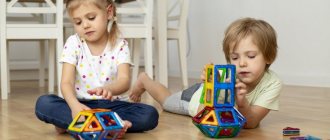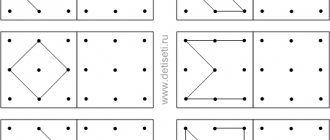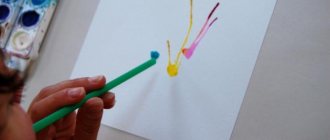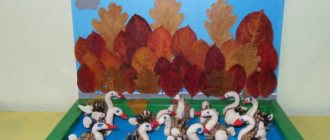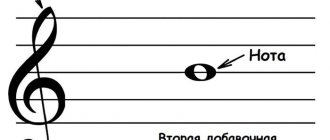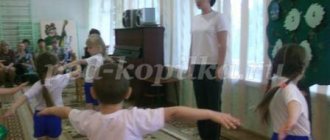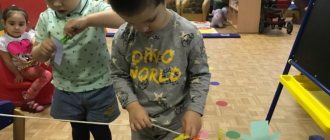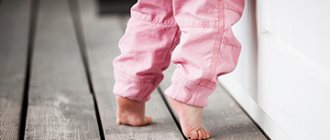Every parent has at least once wondered what my baby should be able to do and know in order to develop harmoniously, keep up with his peers and not experience difficulties in the future when entering school. Especially when an example is given to a child who at 4 years old reads books on his own and plays the violin.
The criteria for developmental requirements for preschoolers are different. On the one hand, child psychologists strongly advise not to take away childhood from children. Fill it with fun, walks, games, creativity. It is recommended to start regular training sessions at the age of five.
On the other hand, the modern world of information and technology is so dynamic that parents fear that in the two years before school, the child will not have time to master the entire necessary amount of skills and knowledge or it will be very difficult for him.
IS THERE A MANDATORY STANDARD?
The state does not impose special requirements for the preparation of young children. The federal standard contains only general guidelines towards which preschool education should be directed. These are the simplest self-service skills, activity, the desire to imitate adults and peers, fluency in speech, and showing interest in culture and nature.
Another party that controls the development of a preschooler is a neurologist who monitors the baby from birth. The purpose of its monitoring is to track the manifestations of possible diseases, since even a slight delay in development can be their consequence.
Below is a list of characteristics that a child should have at 4 years old. It is compiled based on the general requirements that are usually presented to children of this age. Its points are a strong recommendation, but not at all a binding law. The main thing is to awaken the child’s interest in development and support his interests, giving them a constructive direction.
If it seems to you that your baby is lagging behind in some way and you want to “pull him up,” be patient and imaginative. The most reliable method for teaching a four-year-old is through play. It is advisable to teach all skills and abilities through play and creative exploration, using fun lessons, directing the child’s positive energy to cognitive activity.
Try to ensure that developmental programs do not limit the natural cognitive aspirations of a growing child and do not match the curriculum at school. If a child in the first grade is bored in class, this will kill interest in learning and further problems with academic performance will begin.
THINKING, MEMORY AND ATTENTION
At 4 years old, a child usually already goes to kindergarten or begins education at a developmental school. From this moment on, you need to prepare the baby for independence in actions and decisions.
Thinking, attention and memory of a four-year-old:
- the baby must be well oriented in the space familiar to him, know the way home along the previously traveled route;
- can concentrate his attention for 7 minutes without being distracted by extraneous matters;
- remembers his full name, parents' names and address;
- remembers events that happened to him in the near future, can retell the most memorable moments;
- working with pictures, quickly finds similarities and differences, determines which group certain objects belong to;
- is able to compose a short story based on one picture or a series of them;
- assembles puzzles from large parts;
- determines where left, right, top, bottom, front, back are;
- quickly learns simple quatrains and rhymes;
- remembers the name and plot line of a story, fairy tale or song and can remember and retell them by looking at the illustration;
- repeats a simple combination of movements while exercising or dancing;
- reproduces a simple chain of words by heart and can restore the order of the elements in the pyramid;
- assembles a block constructor according to a given scheme or design.
PHYSICAL DEVELOPMENT
From the age of three, the baby’s appearance changes, he noticeably “grows up”, and his muscular system strengthens. At 4 years old, a child moves a lot, but, as a rule, it is too early to send him to a section. Most sports clubs accept children from 5 years old. Physical exercises should be aimed at general strengthening.
Physical formation of a baby at 4 years old:
- at this age the child is active, he runs quickly and jumps well in height and length;
- climbs up the Swedish stairs and descends without fear;
- catches the ball with both hands and throws it at the target;
- with the help of adults, pulls himself up on the bar;
- overcomes a simple obstacle course (climbs a hill, crawls through a tunnel, jumps over “ravines”, etc.);
- bends low from a standing position and forward while sitting.
It is very important to teach a child of this age a variety of active games (football, lapta, “zhigal”, etc.) and introduce him to new sports (skiing, skating, running, swimming, wrestling, athletics, etc.). This is important not only for the health, endurance, strength and flexibility of his body. Such activities perfectly develop his attention, thinking, develop useful habits, and generally have a positive effect on the development of his personality.
It has long been noted that physically active children who possess a variety of motor skills and engage in one or more sports are intellectually more developed than their peers. They study better and master the school curriculum faster, adapting to new conditions faster.
conclusions
So, 4 years is a period of discovery, both for the baby and for his parents. A four-year-old child actively learns about himself and the world, his abilities and talents manifest themselves. The skills acquired earlier continue to be improved. The child’s intensive physical, mental and personal development occurs: the baby learns to control his body and emotions, memory, attention, thinking, speech and imagination develop. Four-year-olds simply need to communicate with their peers, because the development of children occurs mainly in role-playing games.
SPEECH DEVELOPMENT
The speech apparatus is already quite well developed, but some sounds may still be difficult to achieve. Before the age of five, visiting a speech therapist is not necessary, but it is important to prevent problems with sound pronunciation with the help of articulatory gymnastics.
Speech development of a 4-year-old child:
- the child pronounces all sounds well (slight difficulties in pronouncing hissing sounds and the letter “r” are still acceptable);
- answers questions correctly;
- can come up with a story consisting of several sentences;
- recognizes intonation in conversations with adults, is able to change the intonation with which he speaks;
- does not confuse masculine and feminine genders;
- uses a large number of new words, constantly introduces new words and phrases into his vocabulary;
- constructs complex syntactic structures in conversation;
- distinguishes between singular and plural;
- correctly uses gender, number and case, choosing the endings of words;
- uses all parts of speech (nouns, adjectives, verbs, etc.) in communication;
- easily selects various adjectives in the description of an object.
It is very important that a child at this age can actively communicate not only with his family, but also with other adults and children. If he still does not speak (or only those close to him understand him), parents should immediately contact a neurologist. The sooner the cause of the delay is identified, the faster and more effective the treatment will be. The development of a child as a whole will be more successful the sooner he learns to freely express his thoughts.
At this age, a preschooler is already able to distinguish his native speech from a foreign one, so he can begin learning English or another language.
When should you worry about your child's development?
Features of a child that at the age of four may indicate developmental delay:
- cannot concentrate on one activity even for a few minutes;
- does not control emotions, outbursts of aggression occur;
- does not play with toys and is not interested in them;
- does not use complex sentences in speech, generally has difficulty expressing thoughts orally;
- too mobile or, conversely, very slow.
If you notice such symptoms in a child, consult your local pediatrician.
FINE MOTOR SKILLS
How developed should fine motor skills be in a 4-year-old child?
- he can easily thread the cord through several holes;
- strings beads of different sizes onto a thread;
- is able to show combinations of fingers, combining them into groups;
- tries to correctly grasp a spoon, pen, pencil, paintbrush, etc.;
- circles several points with a pen, connecting them into the outline of an object;
- colors the drawing without going beyond a fairly thick outline (it is quite acceptable if there are unpainted voids left);
- can use a stencil;
- molds from plasticine not only large, but also small parts, connects them together;
- cuts evenly with scissors along a given contour.
In general, the development of fine motor skills contributes to the all-round development of the baby, so a variety of hand games and arts and crafts activities are still welcome.
At the same time, many psychologists note that you should not be upset if your baby does not know how to hold a pen correctly. You should teach him gently and patiently so that at the age of 5 he can hold a pen the way he needs to.
Plan for conducting developmental classes with preschoolers 4-6 years old
Social and psychological support programs:
- development of mental processes (attention, memory, perception, thinking)
- development of the emotional-volitional sphere of preschool children
- development of creative thinking, artistic abilities and fine motor skills
- reduction of hyperactivity
- learning to manage your emotions, developing proper communication skills, reducing the level of aggression.
Main goals Ways of implementation Methodological materials development of fine motor skills games with mosaics, dot drawings, assembling construction sets, modeling mosaic, constructor, paper, pencils, plasticine development of attention and perseverance, spatial orientation complete the drawing or find the missing details of the image, assemble puzzles, cups with pictures games for finding objects and placing them
puzzles, cubes, drawings (samples) other small items, toys
development of short-term memory lay out the pictures (objects), close them and ask the child to repeat the row any objects, pictures development of integrity of perception, understanding of the subject contour images of animals, objects - guess what it is and color it outline images, pencils development of logical thinking laying out a series of pictures: from large to small, by color, find the extra picture series of pictures development of creative potential, the ability to assemble parts into a whole assembling a whole meaningful object from designer parts different types of construction sets (trains) teaching the concept of geometric shapes games with geometric shapes set of pictures with figures training perseverance, relieving symptoms of hyperactivity games aimed at concentration ball, sticks, cubes, soft toys learning to express emotions, the ability to transform into another person (animal) play theater based on fairy tales (“Teremok”, “Turnip”) fairy tale props teaching the basics of mathematical knowledge Counting to 10 and back, examples of addition and subtraction Cubes with numbers, teaching aids teaching basic reading Games with sounds and letters, drawing letters, adding words Teaching aids, cubes with numbers, paper, colored pencils. increased self-confidence and sense of security.
Basic socio-pedagogical and psychological skills of children of middle and senior preschool age:
- Special skills and abilities:
Math knowledge:
- counting to ten in ascending and descending order, the ability to recognize numbers in a row and separately, quantitative (one, two, three...) and ordinal (first, second, third...) numerals from one to ten;
- previous and subsequent numbers within one ten, the ability to compose numbers of the first ten;
- recognize and depict basic geometric shapes (triangle, quadrangle, circle);
- shares, the ability to divide an object into 2-4 equal parts;
- basics of measurement: a child must be able to measure length, width, height using a string or sticks;
- comparison of objects: more - less, wider - narrower, higher - lower;
- the basics of computer science, which include an understanding of the following concepts: algorithms, information coding, a computer, a program that controls a computer, the formation of basic logical operations - “not”, “and”, “or”, etc.
- Development of fine motor skills:
From 4 to 6 years old, a child should be able to:
— build a bridge from 5 cubes
- draw a cross
- draw a square
— draw a man (3-6 elements)
- Psychological characteristics:
- Perception
By older preschool age, it becomes more perfect, meaningful, purposeful, and analytical. It highlights voluntary actions - observation, examination, search. Children know the primary colors and their shades, and can describe an object by shape and size. They learn a system of sensory standards (round like an apple).
- Memory.
Involuntary memory should be gradually replaced by voluntary memory; children learn to remember at will. In middle preschool age (between 4 and 5 years), voluntary memory begins to form. For a 6-year-old child, such a task is quite accessible - remember 10 words that are not related in meaning.
- Thinking.
Visual-effective thinking (manipulation of objects) is improved, visual-figurative thinking (manipulation of images and ideas) is improved. For example, children of this age can already understand what a room plan is. Using the group room diagram, children can find the hidden toy. The games “Find the treasure” and “Labyrinths” are useful. And the prerequisites for logical thinking begin to actively form, which is finally formed by the age of 14. The ability for induction and deduction develops.
- Attention.
An important indicator of the development of attention is that action according to the rule appears in the child’s activities - the first necessary element of voluntary attention. A child of 5-6 years old should be able to concentrate on necessary, but not interesting, activities for at least 5-10 minutes.
- Speech
.
The sound side
develops .
Younger preschoolers begin to realize the peculiarities of their pronunciation. The vocabulary
is growing rapidly .
The grammatical structure
develops . Children learn morphological (word structure) and syntactic (phrase structure) patterns.
- Imagination:
becomes active - voluntary. Imagination also plays another role - affective and protective. It protects the growing soul of the child from excessively difficult experiences and traumas.
- Features of the personal characteristics of a preschooler:
- Emotional sphere.
By older preschool age, the structure of the emotional processes themselves changes. In early childhood, they included vegetative and motor reactions. The external expression of emotion becomes more restrained in some children. The child begins to be happy and sad not only about what he is doing at the moment, but also about what he still has to do.
- Motivational sphere.
The most important personal mechanism formed during this period is the subordination of motives. It appears at the beginning of preschool age and then develops consistently. If several desires arose simultaneously, the child found himself in an almost insoluble situation of choice. The strongest motive for a preschooler is encouragement and receiving a reward. A weaker one is punishment, an even weaker one is the child’s own promise.
- Preschooler starts internalize ethical standards
accepted in society.
He learns to evaluate actions from the point of view of moral norms, to subordinate his behavior to these norms, and he develops ethical experiences. Initially, the child evaluates only the actions of others - other children or literary heroes, without being able to evaluate his own. In middle preschool age, the child evaluates the actions of the hero regardless of how he treats him, and
can justify his assessment based on the relationships of the characters in the fairy tale. In the second half of preschool childhood, the child acquires the ability to evaluate his own behavior and tries to act in accordance with the moral standards that he learns. - Self-awareness
is formed by the end of preschool age due to intensive intellectual and personal development, it is usually considered the central new formation of preschool childhood. Self-esteem appears in the second half of the period on the basis of an initial purely emotional self-esteem (“I am good”) and a rational assessment of other people’s behavior. The child first acquires the ability to evaluate the actions of other children, and then his own actions, moral qualities and skills. By the age of 7, most self-esteem of skills becomes more adequate. Another line of development of self-awareness is awareness of one’s experiences. At the end of preschool age, he orients himself in his emotional states and can express them in words: “I’m happy,” “I’m upset,” “I’m angry.”
Plan for individual lessons (or small group lessons) with preschoolers
Lesson 1.
Testing the children with whom classes will be conducted to identify existing general and special skills and abilities, drawing up a more specific lesson plan taking into account the areas of work.
Lesson 2.
Development of a child's fine motor skills.
The game “Mosaic” is to put together a picture using parts of a plastic mosaic according to a sample. Time - 15 minutes.
The game “Collect peas” - the peas are placed in a jar of cereal, the task is to “catch” all the peas with your hands and put them in another bowl. Time - 10 minutes.
The game “Connect the dots” - the dots indicate the outline of the drawing, the task is to circle the dots so that the outline is complete. Time - 10 minutes.
Mobile physical education (finger gymnastics) - 10 minutes.
The game “Make a Hedgehog” - the task is given to make an animal figurine from plasticine according to the model. Time - 15 minutes.
Lesson 3.
Development of spatial orientation skills.
The game “Complete the picture” is a task to determine what is missing from the image in the picture and complete the missing detail. Time - 10 minutes.
The game “Assemble the puzzle” is a task to assemble a picture from parts. Time - 20 minutes.
Mobile physical education (finger gymnastics) - 10 minutes.
The game “Place in order” - the order of placing objects is spelled out, for example, put the red cube on the blue one, and the green one behind the red one (option: “draw a dot on the paper in the upper right corner”) and a task is given to complete. Time - 20 minutes.
Lesson 4.
Development of memory, perception, thinking.
Game “Guess Who” - outline images of objects are given, you have to guess what it is and color it. Time - 15 minutes.
The game “Select the right one” - you are given drawings of objects drawn on top of each other, you need to find a specific image. Time - 15 minutes.
Mobile physical education (finger gymnastics) - 10 minutes.
The game “What has changed” - objects are laid out, the child is asked to remember and turn away. Then the order of objects is changed, new ones are added or old ones are removed. The child must say what has changed. Time - 20 minutes.
Lesson 5.
Development of logical thinking.
The game “Place in order” - objects (pictures) are given that need to be arranged in order - from largest to smallest, from thick to thin, etc. Time - 15 minutes.
Game “Find the odd one out” - there is an object in the picture that is not included in the group (for example, a lemon in a bowl). We need to find him. Time - 10 minutes.
Mobile physical education (finger gymnastics) - 10 minutes.
Game “Guess” - a picture is shown with a separate image of objects (for example, a wheel, steering wheel) - what is this? Time - 10 minutes.
Game “Counting Sticks” - tasks for using counting sticks, for example:
- Lay out a square, triangle, rectangle;
- count the number of sticks in each figure;
- name the geometric shapes that make up the figure;
- count the geometric shapes that make up the overall figure (how many triangles? squares?);
- count the angles included in the figure;
- build a figure according to the model;
- come up with and put together the figure yourself.
Time - 15 minutes.
Lesson 6.
Development of creative potential.
The game “Assemble a figure” is to assemble several different figures from the proposed construction set. Time - 20 minutes.
Mobile physical education (finger gymnastics) - 10 minutes.
Game “Imagine an Animal” - come up with and draw (with paints, pencils) a fairy-tale animal. Time - 15 minutes.
The game “Pretend an Animal” is to use movements and sounds to show an animal, real or imagined. Time - 15 minutes.
Lesson 7.
Teaching concepts of geometric shapes.
Game “Name the Shape” - images of geometric shapes are shown, you need to name them and say what they look like. Time - 15 minutes.
Game “Make an Animal” - the task is given to make an animal from geometric shapes of different sizes. Time - 15 minutes.
Mobile physical education (finger gymnastics) - 10 minutes.
Game "Volume" - the concepts of flat and three-dimensional figures are given, what three-dimensional figures look like. Time - 20 minutes.
Lesson 8.
Training in perseverance and concentration.
Game “Remember” - on the count of 1, you need to raise your arms to the sides, 2 - up above your head, 3 - clap your hands, 4 - lower your hands down. The child does an exercise. The pace gradually increases. Time - 10 minutes.
Game “Complete the task” - the task is spoken out, for example, you need to sequentially clap your hands, sit on a chair, and close your eyes. Upon signal, all tasks are completed. The tasks gradually become more difficult. Time - 15 minutes.
Mobile physical education (finger gymnastics) - 10 minutes.
The game “Cross out the object” - you are given a sheet of paper with drawn icons that need to be crossed out. Time - 10 minutes.
The game “Catch the Number” - different numbers are called, for example, upon hearing 5, the child claps his hands. Time - 5 minutes.
The game “Collect the red ones” - from the scattered colored pieces of paper you need to choose only the red ones, for example. Time - 10 minutes.
Lesson 10.
Teaching the basics of counting.
Game “Fun Problems” - a small task is spoken out, for example: Kolya bought a red ball, and Dima bought 2 green ones. How many balls do they have in total? Time - 10 minutes.
The game “Find the Number” - the drawn number is “hidden” in the picture, you need to find it, also guess by touch, by drawing with your finger on the back, etc. Time - 10 minutes.
Game “Find a Pair” - you are asked to find an object similar to the one proposed: in color, shape, size, etc. Time - 10 minutes.
Mobile physical education (finger gymnastics) - 10 minutes.
Game "Matryoshka" - a set of nesting dolls is asked to be counted, collected and placed in order. Time - 10 minutes.
Game “Count” - how many items are there? We count, add, subtract. Time - 10 minutes.
Lesson 11.
Teaching the basics of reading (for older preschoolers).
The game “Find the Letter” - different letters are “hidden” under different images, you need to find it and guess it. Time - 15 minutes.
The game “Finish the word” is called a syllable, for example, KA. A ball is thrown to the child and he must finish the word (KA-SHA, KA-TYA). Time - 15 minutes.
Mobile physical education (finger gymnastics) - 10 minutes.
Game “Guess the sound” - words that are similar in sound are called, you need to choose the odd one out. For example:
NORA, NORA,
IT'S TIME , NORA. EAR, EAR, EAR, HAIR . SPIT , GOAT, GOAT, GOAT. BOW, BOW, PLOW , BOW. CAP, CAP , CAP, CAP. MOLE, MOLE, MOUTH , MOLE. CAT, YEAR , CAT, CAT. HONEY, HONEY, HONEY, ICE . WALRUS, CORZH , WALRUS, WALRUS. FISHING FISHING FISHING FISHING FISHING FISHING FISHING FISHING FISHING FISHING FISHING FISHING FISHING FISHING FISHING FISHING FISHING FISHING FISHING BOUQUET, BOUQUET, BOUQUET, COUPLET . HERON, HERON, DROP , HERON. HOUSE, HOUSE, HOUSE, VOLUME . DAUGHTER, PERIOD , DAUGHTER, DAUGHTER. CANE , NAIL, NAIL, NAIL.
Time - 10 minutes.
The game “Guess the Syllables” - the child is taught to distinguish syllables, clap their hands as many times as the number of syllables he hears. Time - 10 minutes.
Lesson 12.
Development of fine motor skills, attention, perseverance.
The game “Unravel the Path” - you are asked to unravel the drawn labyrinth (the squirrel is looking for a fungus). Time - 15 minutes.
Game “Complete the object” - half of the object is drawn and you are asked to complete the rest. Time - 15 minutes.
The game “Do the same” - a pattern (object) is made from a mosaic or construction set - it is proposed to be repeated. Time - 10 minutes.
Mobile physical education (finger gymnastics) - 10 minutes.
The game “What’s missing” - a drawing is given of an object that is missing a part (a horse’s tail). The child must determine what is missing and fill it in. Time - 10 minutes.
FEATURES OF RELATIONSHIPS OF A PRESCHOOL CHILDREN WITH PEERS AND “ALIANS” ADULTS
In order for a child to properly build relationships outside the family, he must have a positive example within the walls of his home. The way parents treat him and the other children, and each other, becomes the standard of behavior.
The feeling of “back”, the child’s awareness that he is supported and loved for who he is is the best incentive for development. At this age, the child separates from his parents and establishes stable contacts within his peer group. If he is sure that everything is in order in the family, he is accepted and loved, he will spend all his energy on communication and developmental activities.
At the same time, if he worries about unstable relationships at home, experiences fears about one thing or another, this will largely “take away” his energy and slow down his mental development.
At 4 years old, a child should already have an idea of:
- that one should not cause pain or offend;
- you need to be able to share, determine the turn of who should play or take an item;
- you need to ask for forgiveness if you have done something bad for someone else.
If a child “keeps to himself” in a group of his peers, while everything is fine in the family, perhaps he is simply an introvert. If conflicts and disagreements constantly arise in the children's environment, this problem should be discussed with other participants in the “process”.
With other adults who surround the baby, he should:
- show respect, say “you”;
- show a certain degree of distrust (do not accept gifts without parental permission, do not leave with strangers, and so on);
- follow the rules of conduct in a preschool institution, in particular, calling adults by their first and patronymic names.
HOME RESPONSIBILITIES AND SELF-CARE SKILLS
At the age of four, children are very active. The kid tries to try everything in practice: prepare a drink, wash a toy, wash the dishes, shine dad’s shoes, etc. Adults should try to direct his energy to mastering new self-care skills (he should already be able to fasten/unfasten a zipper, buttons, hooks, Velcro, put on his own outerwear and shoes, wash himself and brush his teeth).
Parents should not limit their child’s activity in acquiring new skills. He should not be left unattended, but at the same time he should not be severely punished for broken dishes, spoiled food, clothes, etc. At this age, the child becomes involved in creative activities and his imagination quickly develops. If you strictly suppress his independent activity, this will lead to his indecisiveness and isolation, which will become a significant obstacle to his further development.
Even if some things were damaged (your knees got dirty during a walk, your jacket was torn, you found lunch in the kitchen with a significant amount of salt and mustard added, your dad washed his socks with your shampoo, etc.), you should sincerely praise the child for his resourcefulness and originality. solution. After this, it is worth showing him how best to act in this case. In this case, you can use the phrases: “I would be so happy if I took this for this work...”, “you know, you did great, but I think that you will achieve an even better result if you use this... ", "I like your work, what do you think: can I avoid these stains next time? Do you have ideas?"
At the age of 4 years, a child should already be able to easily navigate his surroundings in the house. Know where things that you cannot take are located and use common things (bathroom, toilet) independently.
Four years is the time when parents can expand the child’s range of household responsibilities. If earlier he had to take care of his clothes and put his toys away after playing, now he needs to be taught how to make his bed in the morning, take soiled clothes to the laundry, and prepare his things in advance.
New responsibilities may include working for the benefit of the whole family. For example, a child can monitor the order in the bathroom: make sure that there is always soap, shampoos and brushes are standing straight, the towel is hanging on the dryer or has been replaced with a clean one.
Basic knowledge and skills at 4 years old
What a child should be able to do at four years old - basic knowledge and skills:
- good control of your body: confidently move and navigate in space;
- be able to count to five and know what numbers up to five look like;
- it is enough to speak well: speech should become clearer compared to the age of three;
- possess self-service skills;
- understand some social norms: for example, distinguish good actions from bad ones.
READING AND LITERACY
Some children can already read intuitively at the age of four, but this is the exception rather than the rule. The same rule applies to literacy as to mathematics: if the child shows interest, you should patiently teach him. You can't act forcefully! Moreover, compare with other children: “Petya is already reading, but what about you?”
It is believed that five years is the best age to start, since by 1st grade a child should already be able to read confidently. However, only the correct training techniques should be used.
If a child can read fluently at 4 years old, adults should not abuse this. Reading fairy tales and children's stories together before bed or during the day should continue to be a family ritual that unites the baby with his parents.
Psychological condition
Four-year-old children do not feel fear well - the task of parents is to tell their son or daughter about possible dangers: about potentially dangerous household appliances, about stray animals, about walking alone.
Normally, a psychologically developed child at the age of four should:
- take into account the assessment of your behavior by significant adults: parents, educators;
- be as independent as possible;
- be able to serve yourself in accordance with your age.
KNOWLEDGE ABOUT THE WORLD AROUND
The age of four is the peak of a child’s cognitive activity aimed at studying culture and nature. Parents should encourage his interest in every possible way, offering joint walks, trips to museums, travel, etc. Games of charades, riddles, studying thematic encyclopedias, games with a world map, etc. are able to activate a child’s interest in the world around him.
If previously gender differences were not so noticeable, now boys are trying to spend more time with their dad doing “male” activities, girls are beginning to be interested in their appearance, clothes, and jewelry.
Advice: The task of parents is to reveal in their child the qualities inherent in nature. If for boys it is: perseverance, willpower, leadership qualities, then for girls it is: gentleness, charm, caring, neatness, etc.
At this age, games become role-playing, the child tries to transform into one or another hero. Parents can use them to help their baby learn different social roles. In addition, a child’s desire to imitate is a great help when learning professions (playing doctor, cook, archaeologist, engineer, etc.). Such activities are very beneficial for his all-round development.
Whatever the development of a child at the age of four, parents should accept the baby as he is. There is no need to try to adjust it to high standards, and it is better to make adjustments without tension, in a playful way that pleases the baby. No success or achievements in life can replace the love and attention of parents, which a child needs more than anything else during this period.
Gender differences in the development of preschool children
Differences in the development of boys and girls become most noticeable by the age of four.
Girls' areas of interest include people, relationships between people, the organization of everyday life, and beautiful household items. Boys are trying to transform the existing order.
In relation to things, girls quickly begin to understand their utilitarian meaning. Boys are interested in the structure of each item and the ability to use it for other purposes than its intended purpose. As a rule, many boys are not particularly thrifty with things.
When included in activities, girls do so actively. The boys are getting ready. Girls ask questions during play with a desire to communicate, and boys ask questions to get the information they need. Girls are more fond of games associated with guardianship, a desire to help, and with an educational function. Boys' favorite games are active, without relying on rules.
Construction. Girls usually act according to a model, unlike boys who constantly fantasize, transform and invent everything.
In speech, girls more often use nouns and adjectives, and boys use verbs and interjections.
Studying the characteristics of children's thinking, researchers noted the main gender difference in the structure of the brain. Girls have a more developed left hemisphere, which is responsible for the development of oral and written speech. In boys, it is the right, which is responsible for spatio-temporal representations. The development of girls is characterized by a predominance of visual-figurative thinking, and for boys - abstract thinking. Girls' memory is long-term, while boys' short-term memory prevails.
